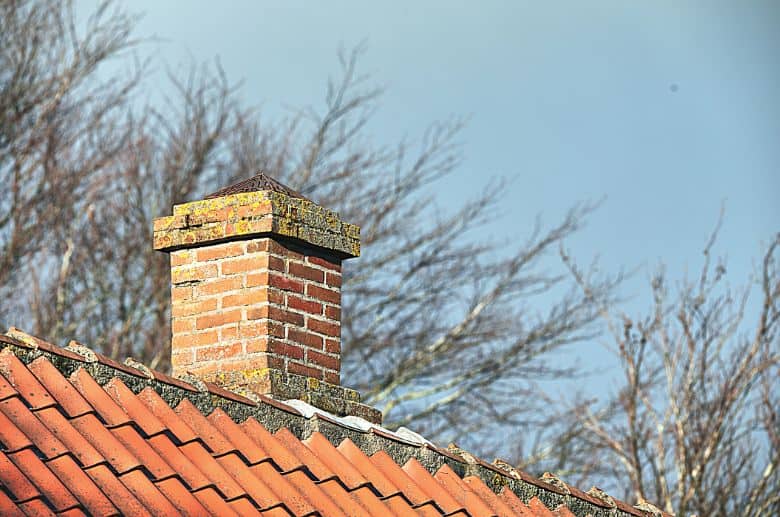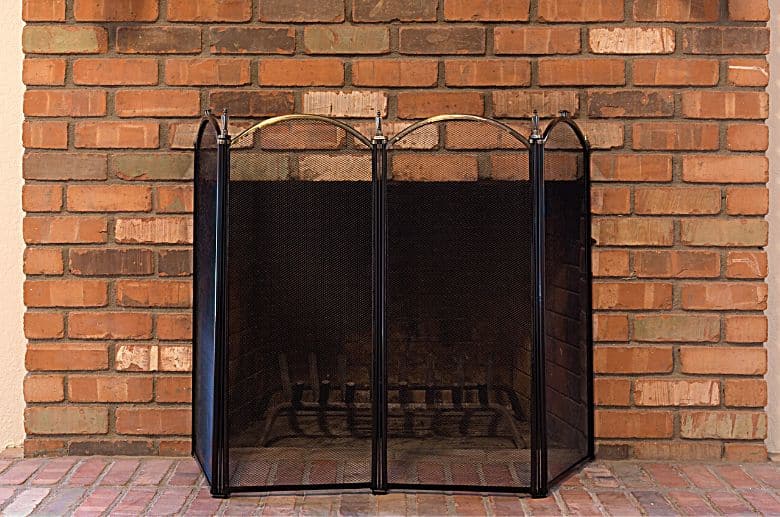A drafty fireplace can be a real problem during the cold winter months.
Not only is it frustrating to feel a chilly draft every time you try to enjoy a fire, but a drafty fireplace can also lead to higher heating bills.
A drafty fireplace can cause cold air to enter your home, making it difficult to maintain a comfortable temperature.
Open masonry wood-burning fireplaces are a leading source of indoor air loss and draft, even more so than windows and doors. Cold air can come in because your fireplace isn’t sealed shut.
In this guide, we will discuss factors that cause a drafty fireplace and provide tips on how to stop chimney drafts.
How does a fireplace draft work?

Many homeowners know the chimney as a structure that gets rid of combustion byproducts like smoke and gasses. But how does a fireplace draft work?
Hot air typically rises up and above cold air. A fire in the fireplace produces hot gasses that create an air pressure difference between the inside of your home and the chimney flue.
This is known as a draft and it allows air into the fireplace, providing adequate oxygen to keep the fire burning while letting combustion byproducts escape through the flue.
Why is my fireplace so drafty?
Here are some common reasons why your fireplace is so drafty:
The Way the Wind blows
The direction that the wind blows can cause a downdraft in the chimney.
In most cases, the wind increases draft and helps draw the smoke and dangerous gasses from your chimney.
Downdrafts happen mostly when there are high winds. The wind blows gusts of air into the chimney causing smoke and gasses to enter your home.
Installing a chimney cowl is a great way to prevent wind-induced backdrafts.
Chimney Length
If you have the wrong chimney length, you will likely experience a drafty fireplace. The right chimney length creates an updraft that enables gasses and smoke to escape.
The part of the chimney above your roof should be at least two feet high. In addition, it should also be at least three feet higher than the tallest structure within ten feet of your roof.
Your chimney shouldn’t be too long either because the hot air from the fireplace will have cooled off when it reaches the top of the chimney.
This creates pressure differences and allows the smoke and dangerous gasses like carbon monoxide to be pushed back into your house.
If your chimney is too short, contact chimney repair services to lengthen or rebuild it.
——
Do You Need to Hire Chimney & Fireplace Expert?
Get free quotes from qualified experts near you. No commitment required!
——
Fireplace Position
First, you should never install your chimney in a room with heating vents as this will affect its efficiency and can be potentially dangerous.
The ideal location for your chimney is a room or place in a room where airflow is great. This is usually the windiest and coldest area of your home during winter.
Since airflow will be good, an updraft will be created every time you start a fire, preventing fireplace draft issues. Remember, you will likely have draft problems if your chimney is on the exterior.
Temperature change
Temperature changes between the inside and outside of your home can cause fireplace drafts.
When not in use, the chimney acts as an air vent. When it is colder outside, cold air enters through the chimney.
Before starting a fire, light kindling or crumbled pieces of paper and hold them below the damper for about two minutes.
This heats the flue and prevents cold air from being drawn into the fireplace when you start a fire.
Chimney Purpose

Homeowners with wood burning fireplaces are likely to experience draft issues because of issues like wrong flue size and wind direction.
In gas-burning fireplaces, the flue has to remain open so cold air easily gets in. So, it is not unlikely to feel cold air in the room when there’s a fire in your gas-burning fireplace.
Installing glass doors on the fireplace opening or direct vent gas inserts are great ways to deal with this problem. A certified chimney sweep can help you install them correctly.
Home Air Pressure
During the winter months, it can get incredibly cold outside. So, the air pressure in the house is typically low, allowing cold air from outside to get into the house through the chimney.
But how does this happen?
When burning wood or gas, the air becomes hot around the fireplace and rises up the chimney flue. It creates a pressure difference, and cold air is drawn in to replace the rising hot air.
This can make starting and maintaining a fire a challenging task. You could open the window in the room with the chimney, but this isn’t an option during the chilly winter months.
Damper is Open
The damper is an important part of the chimney structure. It does the following:
- Allows smoke and gasses like carbon monoxide to escape out of your house through the chimney flue.
- Prevents cold air from entering your home through the chimney when you are not using the fireplace.
- Enables you to increase or reduce oxygen supply. This way, you can control the fire’s intensity.
If you are not using the fireplace, the damper should remain closed. An open damper allows cold air from outside to enter your home, making it colder.
How to stop the draft from the fireplace?
Here are some tips for stopping fireplace draft:
Step 1. Check the damper position
Check if the damper is properly sealed and in the right position. The damper is located at the top of the fireplace and helps to regulate airflow.
If it’s open, simply close it to help reduce the amount of drafty air coming into your home. We recommend closing the damper once the fire and embers in the fireplace have all burned out.
Note that if your damper is damaged, warm air could be escaping and/or cold air could be entering the chimney improperly.
If your chimney damper doesn’t close properly, contact a professional chimney sweep to inspect and fix or replace it.
——
Do You Need to Hire Chimney & Fireplace Expert?
Get free quotes from qualified experts near you. No commitment required!
——
Step 2. Check the chimney to make sure it’s clear and free of debris
Your chimney can only function well if the chimney flue is free of objects. Things that can block the flue include leaves, twigs and seeds if tree branches are above your home.
Over time, soot and creosote can build up in the chimney and contribute to blockage.
If the smoke and gasses cannot escape through the chimney flue, the air will be drawn back and you will have a drafty fireplace.
You can use a high-quality flashlight to check for creosote and debris buildup in the flue. Ensure you wear protective gear like a dust mask and goggles.You could use a hard chimney brush to clean the flue.
But cleaning the chimney flue by yourself (especially if it has not been cleaned for years) is challenging.
Get in touch with an experienced chimney sweep to help you remove the creosote buildup and debris.
Step 3. Place fireplace screen or close the fireplace door

Shutting the front of the fireplace is another excellent way to stop fireplace draft. You can do this by closing the fireplace door or installing a fireplace screen.
When there’s a fire, cold air entering through the chimney can cause a downdraft and make it difficult to keep the fire burning.
A fireplace door reflects the drafty air and ensures combustion byproducts do not enter your house.
Step 4. Inspect the fireplace for any gaps or cracks around the fireplace.
Gaps and cracks in your chimney masonry usually cause a drafty fireplace. Gaps or cracks usually indicate that the masonry is deteriorating or water is leaking through your chimney.
If the brick and mortar in the fireplace are damaged, your fireplace won’t function well and cold air from outside will enter your home. Also, dangerous gasses like carbon monoxide will be present in your house, putting you and your loved one’s health at risk.
If cracks or gaps exist, seal them with caulk or weather stripping to help keep cold air out.
Step 5. Use draft stoppers or draft guards
Draft stoppers or draft guards prevent cold air from getting into your house through the chimney. This enables you to keep your home warm throughout winter. Here’s how to make a draft stopper at home:
Keep in mind that if your fireplace is drafty, it indicates that your chimney is faulty. Issues that can cause draft in the fireplace include:
- The buildup of creosote and debris in the chimney
- Deteriorating brick and mortar in the fireplace
- Damaged chimney cap
Fixing these issues on your own isn’t the best idea as it could cause further damage to the chimney structure. Contact a reputable chimney sweep to take a look and recommend solutions to prevent fireplace draft.
Final Thoughts
A drafty fireplace is a problem many homeowners face. You now understand how to stop chimney drafts. It is good practice to always reach out to a chimney service when dealing with a problem you don’t understand well.






